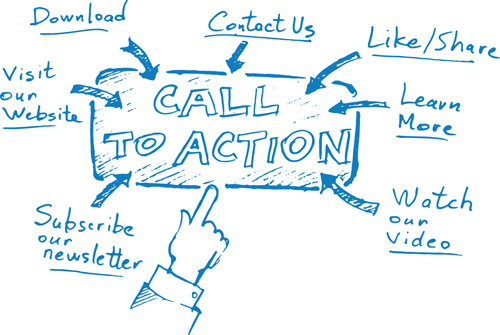A CTA, or call to action, is a powerful and necessary tool in content marketing. You can write informative blogs and release compelling videos, but without CTAs, your visitors won’t be persuaded to act. You want them to explore various areas of your site, interact with your content, and ultimately commit to a purchase. This tool guides your customers in the right direction and funnels them toward conversion. Whether you’re writing a newsletter or posting to social media, it’s a resource you want to take advantage of.
Some businesses make the mistake of avoiding CTAs because due to the direct nature of the approach. However, over 90% of visitors who read your headline also read your CTA. They are effective, and should therefore be utilized. Sometimes, a direct approach is a better method when you’re trying to persuade an audience. This doesn’t mean that you have to use a “hard sell” tone that is too pushy for customers. To be direct, all you have to do is produce well-written and succinct CTA content that delivers a solid message.
Are you wondering how you can improve your strategy and engage viewers on your site? Here’s everything you need to know about CTAs.
What Makes a Call to Action Successful?
A successful CTA has the following characteristics:
- Clarity. If you aren’t clear about what you’re saying, it will confuse your readers and they won’t act. The ultimate goal of a CTA is to influence a visitor and have them complete an action. What do you want them to do? Schedule an appointment, perhaps, or subscribe to your newsletter? Regardless of what it is, you need to say it clearly. Be sure to let viewers know what they can expect by completing a certain task. If you promise that you won’t overwhelm them with e-mails every day, follow through.
- Customized messaging. You don’t want all of your CTAs to sound the same. Readers can recognize poorly written, copied-and-pasted content from a mile away. Always consider your audience and speak directly to them. If you include multiple CTAs in a single piece of content, personalize each one. In your final CTA, for instance, you should assume that the reader has interacted completely with the content. They’re ready to take the next step at this point, and you should include links that take them there.
- Urgency. A CTA isn’t a CTA without an urgent tone. This isn’t the time to use hesitant or meek language. Cut out unnecessary words and get to the point. Be sure to use strong verbs, and don’t leave the “action” out of call to action. For instance, use active phrases like “Get yours today!” or “Contact us now!” You want your viewers to feel like they’re missing out if they don’t take action. The language and tone you use is key, especially when you’re trying to convince others.

- Balance. In most cases, a sales pitch that is over-the-top is not welcome. Consider your own experience. You’ve probably seen someone with a clipboard heading towards your front porch at one point or another. Maybe they knocked on your door several times a week, despite the fact that you never answer. Truthfully, no one wants a salesperson to invade their comfort zone or approach them at an inconvenient time. The same thing applies to your customers online. Balance out your CTAs and read over them carefully before publishing them. If they seem excessive or overwhelming to you, your customers will feel the same. You don’t want them to run the other way when your e-mails hit their inbox. Be mindful of how many CTAs you use and how the language sounds when read aloud.
Three Popular CTA Types You Should Use
Lead Generation
Lead generation CTAs are designed for new readers and viewers. They should be used on main pages, sidebars, floating banners and other high-traffic locations. Usually, you’ll want to use this opportunity to get viewers invested. Having them enroll in a service, request a quote, or subscribe to a newsletter are all examples of lead generation CTAs.
Read More
A “Read More” CTA hooks viewers by cutting off some of the content. In this approach, visitors have to navigate to another page and stay on your site longer. No one likes reading a story without knowing what happens next. By including a “read more” button, you can engage your visitors and encourage them to check out something new. This type of CTA is ideal for blog home pages.
Links to Socials
Sharing your socials is an excellent way to guide visitors in the right direction. Social media platforms provide instant access to visual imagery, live video content and up-to-the-minute information. There’s no faster way to engage viewers and convert them. Moreover, if people can quickly access your social media content, they’ll be more likely share it with others. The domino effect this causes will be highly beneficial in the long run.
Gauge Digital Media Can Optimize Your Web Content
Do you need help crafting effective CTAs? We can optimize your website for search engines to help you get the highest return on your investment. At Gauge Digital Media, we’re experts when it comes to digital marketing, and we’ve helped many clients optimize their approach. We’ll thoroughly examine your content, supervise your ad campaigns, display ads across Google AdWords and Bing Ads, and more. Is there something else you want to achieve? We can assist you.
We Are Here to Help Grow Your Business Online and Through SEO
Working with a professional digital marketing company is the best way to make the most of your website and all that Facebook Pixel, LinkedIn ads, Google Analytics and other digital advertising platforms have to offer. To learn more about the best digital marketing strategies for your company and reach a bigger audience than ever before, work with Gauge Digital Media. For a quote or to schedule a call, contact us at (443) 376-7709.



